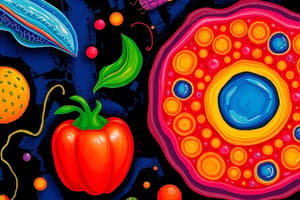Podcast
Questions and Answers
पादपों का शहरी प्रणाली जल और पोषक तत्वों की पहुंच के लिए होता है।
पादपों का शहरी प्रणाली जल और पोषक तत्वों की पहुंच के लिए होता है।
False (B)
पादपों के मिटोकंद्रिया में सेलुलर श्वसन किया जाता है, मुख्यतः रात में।
पादपों के मिटोकंद्रिया में सेलुलर श्वसन किया जाता है, मुख्यतः रात में।
False (B)
संवहनी प्रणाली में हृदय, रक्तसंवहनी, और रक्त होते हैं।
संवहनी प्रणाली में हृदय, रक्तसंवहनी, और रक्त होते हैं।
False (B)
जानवरों का पाचन तंत्र मुख्यतः अपचन का प्रक्रिया सुरू करता है।
जानवरों का पाचन तंत्र मुख्यतः अपचन का प्रक्रिया सुरू करता है।
मुख प्रक्रिया में भोजन को पाचन के लिए सुरू करता है।
मुख प्रक्रिया में भोजन को पाचन के लिए सुरू करता है।
Study Notes
Cell Structure and Functions
Living organisms are composed of cells, which serve as the fundamental building blocks of life. Cells are structured into distinct compartments containing specialized components that enable them to perform various functions.
The cell's inner structure is divided into two main regions: the nucleus, which houses genetic information, and the cytoplasm, containing organelles that perform specific tasks. Some of the most important organelles include:
- Mitochondria: Producing energy through cellular respiration.
- Endoplasmic Reticulum: Synthesizing proteins and lipids.
- Ribosomes: Translating genetic information into proteins.
- Chloroplasts (plants): Capturing light energy through photosynthesis.
Nutrition in Plants
Plants, like all organisms, require nutrients to grow and reproduce. They obtain their nutrients through photosynthesis, which uses light energy, water, and carbon dioxide to produce organic compounds, including sugars and other nutrients.
Plants obtain essential minerals from the soil, primarily through their roots. These nutrients include:
- Nitrogen: Necessary for protein synthesis.
- Phosphorus: Involved in energy transfer and genetic information storage.
- Potassium: Important for water transport, enzyme activation, and cellular processes.
- Calcium: Involved in cell wall maintenance, signaling, and membrane function.
Nutrition in Animals
Animals, unlike plants, cannot produce their own food. They obtain nutrients through consumption of other organisms, mainly plants or other animals.
Animals have evolved specialized organs and structures to help them obtain and process nutrients, including:
- Mouth: Introducing food into the digestive system.
- Teeth: Breaking down food into smaller pieces for easier digestion.
- Stomach: A muscular, acidic organ that begins the process of breaking down food.
- Small intestine: The primary site of nutrient absorption.
Transportation in Plants and Animals
Transportation of water, nutrients, and other essential substances is crucial for maintaining life in both plants and animals.
Plants transport water and nutrients through their vascular system, which consists of xylem and phloem tissue in specialized tissues called vessels, tracheids, and parenchyma cells.
Animals transport nutrients and waste products through their circulatory system, which consists of the heart, blood vessels, and blood. The heart pumps blood through the blood vessels, which deliver nutrients and oxygen to cells and remove waste products.
Respiration in Plants and Animals
Respiration is the process by which living organisms convert biochemical energy stored in organic molecules into a form that cells can use to perform work.
Plants and animals both undergo cellular respiration to produce energy in the form of ATP, but the specific processes and structures involved differ.
Plants perform cellular respiration in their mitochondria, mainly during the night when they are not photosynthesizing.
Animals perform cellular respiration in their mitochondria 24/7, as they do not undergo photosynthesis.
In summary, understanding the structure and functions of cells, the role of nutrients in growth, and the processes of transportation and respiration in both plants and animals is essential to grasping the foundations of biology. Exploring these topics in detail can provide valuable insights into the complex, interconnected systems that make life possible.
Studying That Suits You
Use AI to generate personalized quizzes and flashcards to suit your learning preferences.
Description
Explore the fundamental concepts of cell structure, nutrition in plants and animals, transportation systems, and respiration processes in biology. Learn about the functions of organelles, nutrient absorption, circulatory systems, and energy production in living organisms.





